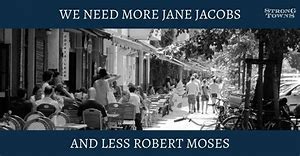This weekend we're in Boston visiting friends. It's Marathon weekend, but wherever we've been the crowds have been pretty well absorbed. We've sampled the public transportation system, which like most places is doing a lot with too few resources. And on Friday they took us on a tour of the North End neighborhood, which played a crucial role in the emergence of new urbanism.
The ur-work of new urbanism is
The Death and Life of Great American Cities by Jane Jacobs (Random House, 1961), a perceptive writer and activist based in New York City. Many of her insights came from living in New York's Greenwich Village, which she helped preserve from the destructive hand of New York's uber-planner Robert Moses. But she also drew on the North End. Here she is, in the introduction, after chronicling the disastrous effects in several cities of what would come to be called "urban renewal:"
Consider, for example, the orthodox planning reaction to a district called the North End in Boston. This is an old, low-rent area merging into the heavy industry of the waterfront, and it is officially considered Boston's worst slum and civic shame. It embodies attributes which all enlightened people know are evil because so many wise men have said they are evil. Not only is the North End bumped up right against industry, but worse still it has all kinds of working places and commerce mingled in the greatest complexity with its residences. It has the highest concentration of dwelling units, on the land that is used for dwelling units, of any part of Boston, and indeed one of the highest concentrations to be found in any American city. It has little parkland. Children play in the streets. Instead of super-blocks, or even decently large blocks, it has very small blocks; in planning parlance it is "badly cut up with wasteful streets." Its buildings are old. Everything conceivable is presumably wrong with the North End. In orthodox planning terms, it is a three-dimensional textbook of "megalopolis" in the last stages of depravity. The North End is thus a recurring assignment for M.I.T. and Harvard planning and architectural students, who now and again pursue, under the guidance of their teachers, the paper exercise of converting it into super-blocks and park promenades, wiping away its nonconforming uses, transforming it to an ideal of order and gentility so simple it could be engraved on the head of a pin (pp 11-12, bolding mine).

In 1959 she visited the North End for the first time in two decades, and was "amazed" at the steady, incremental progress the neighborhood had made.
The streets were alive with children playing, people shopping, people strolling, people talking. Had it not been a cold January day, there would surely have been people sitting.
The general street atmosphere of buoyancy, friendliness and good health was so infectious that I began asking directions of people just for the fun of getting in on some talk. I had seen a lot of Boston in the past couple of days, most of it sorely distressing, and this struck me, with relief, as the healthiest place in the city. But I could not imagine where the money had come from for the rehabilitation, because it is almost impossible today to get any appreciable mortgage money in districts of American cities that are not either high-rent, or else imitations of suburbs (pp 13-14).
So she called an acquaintance in the planning department of the City of Boston.
"Why in the world are you down in the North End?" he said. "Money? Why, no money or work has gone into the North End. Nothing's going on down there. Eventually, yes, but not yet. That's a slum!" (p 14)
As it happens, though, the crime and health statistics for the North End were vastly better than other neighborhoods of similar social class; not only that, but the planner admitted he liked dropping by every now and then.
I often go down there myself just to walk around the streets and feel that wonderful, cheerful street life... But of course we have to rebuild it eventually. We've got to get those people off the streets (pp 14-15).
 |
| Where we ate. Restaurants have been a major economic contributor to the North End for years |
By some miracle, benign neglect or local activism, urban renewal never came to the North End. It suffered the construction of the Central Artery in the 1950s, and then the dislocation of its reconstruction (the "Big Dig") 15-20 years ago, but out of all that came the Rose Kennedy Parkway promenade.
Today the North End is one of the hottest areas of the city. The gentrification has come with the inevitable displacement of some of the longtime Italian residents, so it's far from paradise. But the success of the North End, in the face of all scorn and neglect, helped to inspire the urbanism of today that may yet save the world.
 |
| Source: strongtowns.org |












No comments:
Post a Comment